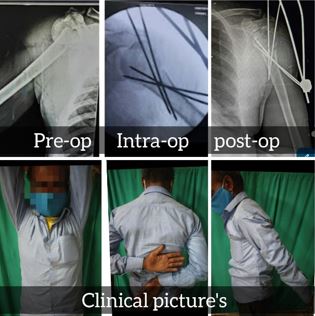Prospective study to evaluate the benefits of percutaneous K-wires system in Proximal Humeral Fractures in Elderly Population: Our Experience
Abstract
Introduction: Proximal humeral fractures are extremely common injuries. The incidence of fracture of the proximal humerus is bimodal in geriatric due to osteoporosis and in adolescents due to high-energy trauma. Recent trends are shifting away from open reduction and massive internal fixation (by plates and screws) toward closed reduction and percutaneous fixation as this method is less invasive soft tissue damage and minimal risk of iatrogenic avascular necrosis. The purpose of this study was, to preserve the biological integrity of the humeral head and to secure anatomical reduction with multiple k wires with angular stability also improve stability of fixation osteoporotic humeral bones.
Material and methods: A prospective study was performed on all patients diagnosed with intra-articular proximal humerus fracture presenting to us from Nov 2018 to June 2022. Only patients with closed, displaced two or three part fractures as per Neer’s classification were included in the study. Fractures were managed by close reduction and percutaneous pinning with K wires and some cases which were linked by a fixator rod using clamps.
Results: Twenty patients comprising of 12 females and 08 males were followed for an average period of 12 months. Mean age of the patients was 58 years. Fall was the most common mode of injury in 15 patients followed RTA injury in 5 patients. All patients achieved full functional range of motion by the end of 4 months. Out of Twenty patients 06 (30%) patients showing excellent results, 12 (60%) patients having good results, and 02(10%) patients having fair results, no patient having poor result.
Conclusion: percutaneous K wire fixation using the external fixator mini clamps and rods is an effective and economical method allowing biological preservation with good results.
Downloads
References
2. Proximal Humerus Fractures: Evaluation and Management in the Elderly Patient - PMC [Internet]. [cited 2022 Nov 7]. Available from: https://www.ncbi.nlm.nih.gov/pmc/articles/PMC5788098/
3. Clinical and functional outcome of proximal humerus fractures treated with locking compression plate (LCP) in adults – A prospective study - IJOS [Internet]. [cited 2022 Nov 7]. Available from: https://www.ijos.co.in/html-article/12962
4. Schumaier A, Grawe B. Proximal Humerus Fractures: Evaluation and Management in the Elderly Patient. Geriatr Orthop Surg Rehabil. 2018 Jan 25;9:2151458517750516.
5. Carofino BC, Leopold SS. Classifications in Brief: The Neer Classification for Proximal Humerus Fractures. Clin Orthop. 2013 Jan;471(1):39–43.
6. Neer classification of proximal humeral fractures | Radiology Reference Article | Radiopaedia.org [Internet]. [cited 2022 Nov 7]. Available from: https://radiopaedia.org/articles/neer-classification-of-proximal-humeral-fractures-1
7. Evaluation of functional outcomes of a modified technique for percutaneous pinning of proximal humeus fracture [Internet]. [cited 2022 Nov 7]. Available from: https://www.researchgate.net/publication/324838667_Evaluation_of_functional_outcomes_of_a_modified_technique_for_percutaneous_pinning_of_proximal_humeus_fracture
8. Evaluation of the Constant score: which is the method to assess the objective strength? | BMC Musculoskeletal Disorders | Full Text [Internet]. [cited 2022 Nov 8]. Available from: https://bmcmusculoskeletdisord.biomedcentral.com/articles/10.1186/s12891-019-2795-6
9. (PDF) K-Wire Fixation of Proximal Three Part Humerus Fractures - An Everlasting Result Oriented Technique [Internet]. [cited 2022 Nov 7]. Available from: https://www.researchgate.net/publication/349742589_K-Wire_Fixation_of_Proximal_Three_Part_Humerus_Fractures_-_An_Everlasting_Result_Oriented_Technique
10. Schumaier A, Grawe B. Proximal Humerus Fractures: Evaluation and Management in the Elderly Patient. Geriatr Orthop Surg Rehabil. 2018 Jan 25;9:2151458517750516.

The entire contents of the Orthopaedic Journal of Madhya Pradesh Chapter are protected under Indian and International copyrights. Orthopaedic Journal of Madhya Pradesh Chapter allow authors to retain the copyrights of their papers without restrictions, Authors grant the publisher the right of exclusive publication. The Journal then grants to all users a free, irrevocable, worldwide, perpetual right of access to, and a license to copy, use, distribute, perform and display the work publicly and to make and distribute derivative works in any digital medium for any reasonable non-commercial purpose, subject to proper attribution of authorship. The journal also grants the right to make numbers of printed copies for their personal non-commercial use under Creative Commons Attribution-Non-commercial share alike 4.0 International Public License.

 OAI - Open Archives Initiative
OAI - Open Archives Initiative












